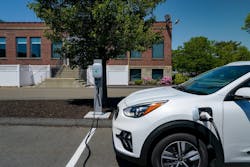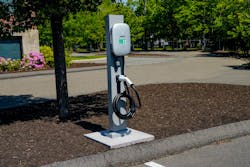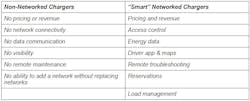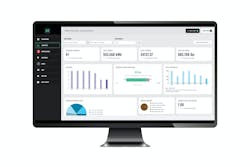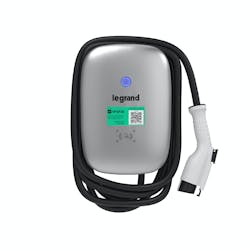OVERVIEW
There is a global trend toward transitioning to electric vehicles (EVs). As more countries continue to announce commitments to shifting to emission-free vehicles, the EV trend will continue to accelerate. Current research predicts that 54% of new car sales and 33% of the global fleet will be electric by 2040. With this rapid adoption of EVs on a global scale, advancements and investments in EV charger infrastructure must occur to keep up with demand. The range of an EV vehicle varies widely, but most reach close to or above 300 miles on a full charge. EV owners regularly charge their vehicles at their home overnight, but more drivers are seeking additional opportunities to charge while away from home to help alleviate common “range anxiety,” or the fear of not having enough energy to make it to their next destination. Meeting this charging demand will necessitate an expansion of a connected network of EV charging stations that can communicate data to optimize the EV charging experience for both end users and charging hosts.
EV CHARGER CONNECTIVITY: THE FUTURE IS SMART CHARGING
As the EV market expands and evolves, the commercial EV charger offering continues to adapt to changing consumer demands and needs. Commercial EV chargers are becoming “smart” and more connected by using the Internet to link and manage individual charging stations.
Networked commercial chargers offer essential front-end and back-end communication features that non-networked chargers are unable to provide. Front-end communication occurs between the EV charger station and the end-user vehicle while back-end communication occurs between the EV charger station and a cloud-managed software solution.
This “smart” charging provides commercial charger hosts with a plethora of charger data that helps to optimize all aspects of EV charger operations and allows a variety of properties, including apartment complexes, office buildings, and large shopping centers, to efficiently manage their charging stations. From more efficient maintenance cycles to simplifying the billing process to monitoring charger usage, networked commercial EV chargers empower charger owners with the level of control needed to drive charger revenue and performance while supporting the demand of new EV drivers arriving on the market.
Connecting intelligent, networked commercial EV chargers requires a robust Internet connectivity method that ensures the reliable exchange of information amongst end users, charging stations, and utility companies.
Currently, there are three different types of networked chargers:
● ETHERNET: Also referred to as “hardwired,” these chargers feature an Ethernet port that allows for direct wiring to the property’s network infrastructure. These chargers provide highly stable and secure data communications, but require a separate data connection to be cabled out to the install location. The overhead cost and extensive complexity of installing, tracing, and maintaining Ethernet cables makes this connectivity option difficult, if not impossible, to scale and impractical to install.
● WI-FI: With Wi-Fi enabled chargers, owners can skip extensive cabling requirements. These chargers feature a built-in Wi-Fi network card that allows the charger to connect to nearby Wi-Fi access points that are typically readily available on commercial premises.
● CELLULAR: These chargers connect to the larger EV network by accessing already established mobile phone networks to exchange data. The chargers feature a built-in cellular modem that allows them to connect to the existing cellular network and does not require any infrastructure from the building owner. The chargers often leverage 4G networks from major carriers including T-Mobile and Verizon. A subscription fee is usually required to establish connection.
Considering the impracticality of Ethernet chargers for the commercial EV market, this article will compare the benefits and limitations of Wi-Fi connected chargers and 4G cellular connected chargers --- and illustrate why cellular connectivity is the future of commercial EV charging.
Source: AmpUp
4G CELLULAR CONNECTIVITY VS. WI-FI CONNECTIVITY
When comparing 4G cellular connectivity to W-Fi connectivity for commercial EV charging infrastructure, there are three main areas where cellular delivers significant benefits compared to its Wi-Fi counterpart: communication, security, and maintenance.
Communication – Range and Reliability
Reliable, uninterrupted data communication is essential to any commercial smart EV charging installation as downtime negatively impacts both the end user experience and the revenue potential for the charger owner. In commercial applications, the exchange of information amongst the end user, charger, and utility company is key for gathering and utilizing current data analytics to optimize charger performance and customer experience. With this communication of data, charger owners can monitor and control key charger operations such as billing processes, daily charger usage, queuing prediction, smart navigation, and intelligent charging schedule management.
Wi-Fi connected chargers are dependent on the quality of the connection provided by local public or private Wi-Fi networks. Charger owners may or may not have control over the quality of the Wi-Fi network and supporting routers. Wi- Fi also uses the more cluttered and unlicensed 2.4GHz and 5GHz frequency bands that are susceptible to interference issues, especially when multiple devices contend for space on the same frequency. Finally, Wi-Fi’s limited range can create coverage problems, especially for owners who want to scale their EV charger offerings.
With mobile networks already established and providing comprehensive coverage on a global scale, 4G cellular connectivity is ideal for commercial EV charger applications, especially for charger hosts seeking to scale their charger network. The 4G cellular network uses regulated, licensed spectrum bands that are highly reliable and less vulnerable to interference issues or outages. When it comes to cellular coverage, newer IoT-focused solutions such as LTE-M and NB-IoT coupled with multi-network SIM cards and multiple redundant data routes help reach difficult and remote areas that may once have been without cellular network access. These qualities allow 4G to deliver an EV charging data communication experience that directly benefits charger hosts by increasing charger uptime, optimizing the end-user experience, and positively impacting revenue potential.
The 4G cellular network uses regulated, licensed spectrum bands that are highly reliable and less vulnerable to interference issues or outages.
Security
Commercial EV chargers are not immune to security threats, but some chargers are better equipped to handle the transmission of sensitive data such as end-user billing details. An EV charger with enhanced connectivity security features can help improve general charger performance as well as foster trust with charger customers.
An EV charger that connects to a Wi-Fi network exposes both the charger and the Wi-Fi network to two-way security risks. The charger can be used by an outside security threat to steal Wi-Fi credentials and access sensitive information. Even private Wi-Fi networks can be compromised, particularly during periods of relaxed security practices such as relying on default Wi-Fi passwords or failing to update the network’s firmware.
With 4G cellular connectivity, many of the security vulnerabilities experienced with Wi-Fi dissipate. The cellular connection separates the charger’s connection from the local Wi-Fi Internet infrastructure, eliminating most security attack points. While connected to a cellular network, a charger’s two-way data communications are encrypted and highly secured through a virtual private network created by newer, cutting-edge cellular IoT solutions. The level of security offered by a cellular connected charger can provide a charging host confidence in the safety of the data collected and transmitted from their EV offerings.
The 4G cellular connection separates the charger’s connection from the local Wi-Fi Internet infrastructure, eliminating most security attack points.
Maintenance (Remote Access)
EV chargers require routine maintenance to consistently perform at an optimal level. Remote access to an EV charger is key to cost-effective maintenance cycles. With remote access, charger diagnostics can be acquired virtually without requiring a technician to travel to the install site, saving time and money. Networked charging stations with remote access capabilities also have a smoother commissioning process as new chargers can be remote configured – an ideal feature for business owners seeking to scale their EV network with multiple chargers.
Attempting to create remote sessions for an EV charger with Wi-Fi connectivity can create a variety of problems. These remote sessions require the local Wi-Fi network’s public IP address to be statically or dynamically traceable – making routers visible and vulnerable to external traffic and security threats. Creating a remote session on these networks also requires a reconfiguration of the Wi-Fi router and firewall rules involving user and network engineer consent. These variables can make a remote session for a Wi-Fi connected router cumbersome and problematic in terms of security.
EV chargers equipped for 4G connectivity circumvent the remote access issues experienced with Wi-Fi by using pre-installed IoT SIM cards that access static, private IP addresses. This creates a virtual private network that prevents a charger from being attacked by external threats. These fixed, private addresses streamline the remote access process by eliminating the need to install additional applications such as dynamic DNS and port forwarding to trace the continually changing IP that is unavoidable with Wi-Fi. This more simplified remote access process enables charger hosts to maintain a more consistent, cost-effective maintenance cycle that ensures optimal charger performance.
CONCLUSION
When it comes to adopting and expanding commercial EV charger infrastructure, 4G cellular connectivity offers exceptional benefits for both the charger owner and charger end users. With highly reliable data communication, robust security features, and remote access capabilities, 4G cellular networked commercial EV chargers will continue to drive the future of the evolving EV charging landscape.
Legrand offers a Networked 4G Level 2 Commercial Electric Vehicle Charger, providing users with a fast, safe, and reliable charging experience in locations where efficiency and access are crucial.
Sponsored by:
